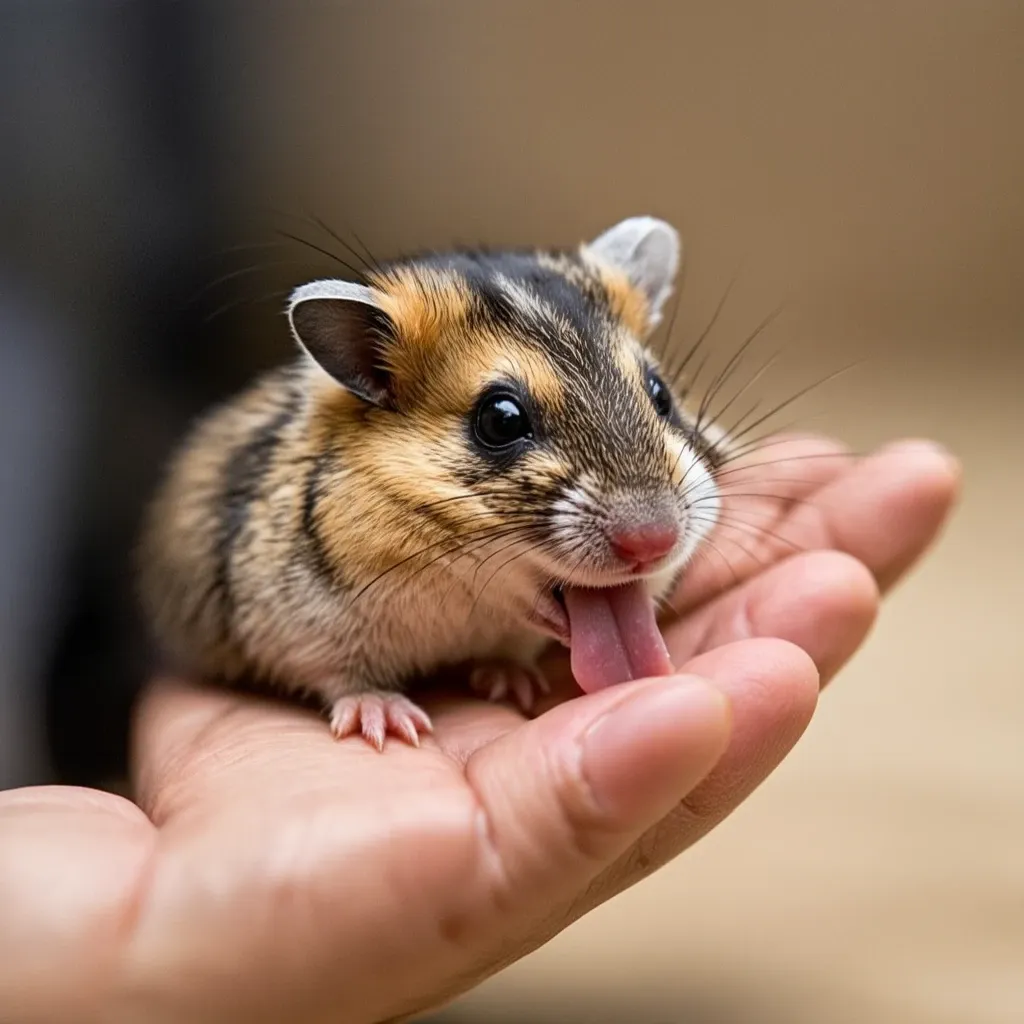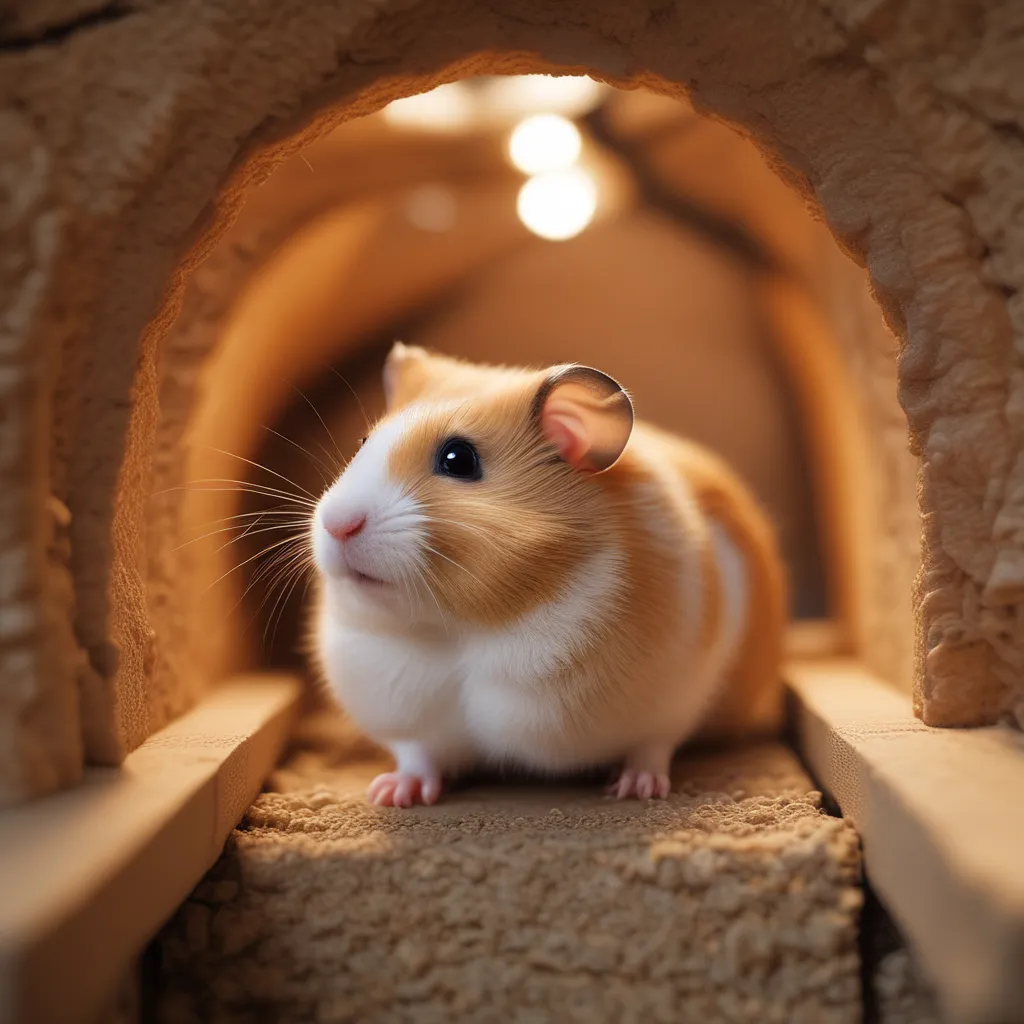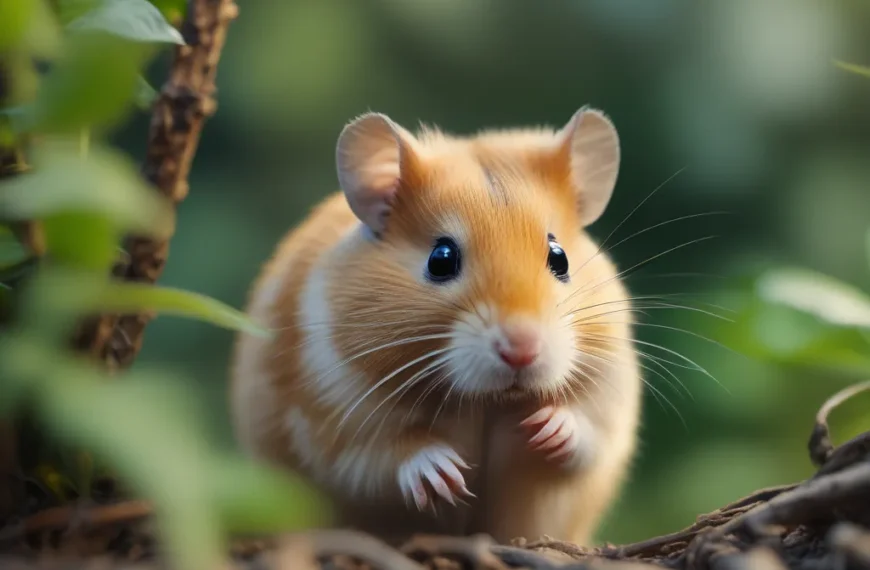Introduction
Do hamsters get lonely? It’s a question many pet owners ask when they see their furry companions spending long hours alone in their cages. While some hamsters thrive in solitude, others may exhibit signs of stress or boredom when deprived of proper interaction or stimulation. Understanding your hamster’s unique social and emotional needs is key to ensuring their well-being.
In this blog, we’ll explore the concept of loneliness in hamsters—what it means, how to recognize it, and how their social needs differ between species. We’ll also share practical tips on preventing loneliness through enriching cage setups and providing the right level of interaction.
By the end, you’ll have the tools to create a happier, healthier environment for your hamster, ensuring they lead a fulfilling life whether kept alone or in pairs.

What is Loneliness in Hamsters?
Loneliness in hamsters refers to a state of emotional distress caused by a lack of interaction or stimulation. While some species, like dwarf hamsters, may enjoy the company of others, others, such as Syrian hamsters, are solitary by nature and prefer to live alone. For pet hamsters, loneliness typically stems from an unengaging environment rather than the absence of companions.
When deprived of mental stimulation or proper care, hamsters may show signs of loneliness, such as lethargy, reduced appetite, pacing, bar chewing, or over-grooming. Prolonged isolation can even lead to stress-related health issues, including a weakened immune system and anxiety.
By understanding the unique social and emotional needs of your hamster, you can identify signs of loneliness early and take action to create an environment that supports their well-being, ensuring a happy and healthy life.
What Are the Emotional and Social Needs of Hamsters?
Hamsters have a variety of emotional, social, and physical needs that must be met to ensure their happiness and well-being. While some species, like Syrian hamsters, are naturally solitary, others, such as dwarf hamsters, may enjoy companionship. Regardless of their social tendencies, all hamsters require interaction, stimulation, and a secure environment to thrive.
Emotionally, hamsters need consistent attention from their owners to prevent feelings of boredom or isolation. Regular handling and bonding sessions help them feel secure and engaged. A comfortable, stable environment—free from stressors like excessive noise or sudden changes—is essential to their emotional health.
Socially, the needs of hamsters vary by species. While Syrians should always be housed alone, dwarf hamsters may coexist peacefully with proper introductions. However, attempts to house multiple hamsters together require careful supervision, as conflicts can arise, even among compatible species.
Physical needs are equally important. Hamsters require ample space to move, explore, and exercise, along with toys, tunnels, and climbing structures to keep them mentally stimulated. A well-designed enclosure encourages natural behaviors and supports their overall well-being.
By understanding the specific emotional, social, and physical needs of your hamster, you can provide an environment that promotes a happy, healthy, and enriched life for your furry friend.
The Social Needs of Hamsters: A Species-by-Species Breakdown
Hamsters have varying social needs that depend on their species. While some thrive in solitary environments, others prefer living in pairs or groups. Understanding these differences is crucial to creating a safe and fulfilling environment for your pet. Below, we break down the social needs of popular hamster species to guide you in meeting their specific requirements.
Syrian Hamsters
Syrian hamsters are solitary by nature and should always be housed alone. They are highly territorial and will fight if kept with other hamsters, even siblings. However, Syrians still require interaction with their owners to stay happy. Regular handling and engaging playtime can help them feel secure and enriched.
Dwarf Hamsters
Dwarf hamsters, including species like Campbell’s and Winter White, are more social and can often live in same-sex pairs or small groups. These hamsters enjoy interacting with one another but must be monitored closely for signs of conflict, as fights can still occur. Providing ample space, multiple hiding spots, and plenty of toys helps maintain harmony in shared enclosures.
Roborovski Hamsters
Roborovski hamsters are social but independent. They may coexist peacefully in pairs or groups, but their high energy levels make them less reliant on social interaction. Whether kept alone or with others, these active explorers benefit greatly from toys, tunnels, and climbing structures to satisfy their curiosity and prevent boredom.
Campbell’s Hamsters
Campbell’s hamsters are friendly and generally tolerate living in same-sex pairs or small groups. They enjoy interacting with their cage mates and their owners, making regular handling and playtime essential. A spacious enclosure with enriching activities is key to reducing stress and fostering positive behaviors.
Winter White Hamsters
Winter White hamsters are another social species that thrive in pairs or small groups. Known for their calm temperament, they enjoy exploring and interacting with both their companions and their human caretakers. To keep them happy, provide stimulating toys and maintain a stress-free environment with adequate space for each hamster.
In conclusion, the social needs of hamsters vary significantly by species. Syrian hamsters are best kept alone, while dwarf, Roborovski, Campbell’s, and Winter White hamsters may thrive in pairs or groups under the right conditions. By understanding your hamster’s specific social tendencies and providing the appropriate environment, you can ensure they lead a happy and healthy life.
Find out how Social intelligence plays a role in how hamsters form bonds.
Signs of Loneliness in Hamsters
Loneliness in hamsters can manifest in subtle but significant ways. While solitary species like Syrian hamsters may not require the company of other hamsters, they still need mental stimulation and interaction with their owners to thrive. Recognizing the signs of loneliness early is crucial to ensuring your pet’s well-being. Below are common indicators of loneliness in hamsters:
1. Changes in Appetite
A lonely hamster may eat less or stop eating altogether, leading to weight loss and potential health issues. Conversely, some hamsters may overeat due to stress or boredom. Monitoring their diet is essential to spotting these changes.
2. Excessive Sleeping
Hamsters naturally sleep during the day, but a lonely or bored hamster may sleep even more than usual, as they lack stimulation or motivation to explore their environment.
3. Pacing or Restlessness
If your hamster repeatedly paces back and forth in its cage or seems restless, it could be a sign of boredom or unmet needs for mental stimulation.
4. Bar Chewing
Chewing on cage bars is a common sign of frustration and boredom in hamsters. This behavior can harm their teeth and should be addressed by providing more engaging activities.
5. Loss of Interest in Toys or Activities
A hamster that ignores toys, tunnels, or other forms of stimulation may be feeling lonely or unengaged. This lack of interest is a clear signal that their environment needs improvement.
6. Poor Grooming Habits
Healthy hamsters are meticulous groomers, so if your pet has matted fur or appears unkempt, loneliness or stress could be the cause. In extreme cases, excessive grooming or hair loss may also occur.
How to Help a Lonely Hamster
If you suspect your hamster is lonely, there are simple but effective ways to improve their quality of life:
- Provide Enrichment: Introduce a variety of toys, tunnels, and climbing structures to keep your hamster mentally engaged. Rotate these items regularly to maintain interest.
- Increase Interaction: Spend more time with your hamster through gentle handling, talking to them, and supervised play outside the cage.
- Enhance the Environment: Ensure their cage is spacious and well-equipped with hiding spots, exercise wheels, and chew toys to mimic their natural behaviors.
- Observe Their Behavior: Monitor your hamster closely to see which activities they enjoy most, tailoring their environment to meet those preferences.
Explore how Crying can indicate loneliness in hamsters.
How Do Environment and Social Interaction Affect Loneliness?
A hamster’s environment and social interactions are critical factors in preventing loneliness and ensuring emotional well-being. Studies have consistently shown that enriched surroundings and appropriate social contact can reduce stress and improve quality of life for these small animals.
The Role of Environment
The physical environment significantly impacts a hamster’s mental and emotional health. A study published in Frontiers in Behavioral Neuroscience found that environmental enrichment—such as the inclusion of toys, tunnels, and exercise wheels—reduces signs of loneliness and stress in hamsters. Conversely, research in Tandfonline revealed that hamsters housed in small cages with limited stimulation were more prone to restlessness, anxiety, and behaviors associated with boredom. Providing a spacious enclosure filled with engaging elements helps mimic their natural instincts, such as burrowing and exploring, reducing the risk of loneliness.
The Importance of Social Interaction
While social interaction is essential for some hamster species, it must be tailored to their nature. Social species like Dwarf, Roborovski, and Winter White hamsters benefit from living in same-sex pairs or groups, as studies in ScienceDirect have shown that companionship reduces stress and anxiety. However, solitary species like Syrian hamsters thrive on interaction with their owners rather than other hamsters. Regular handling, supervised playtime, and vocal reassurance can substitute for social companionship in these cases.
Balancing Environment and Social Needs
Social isolation has been linked to heightened stress and behavioral issues in hamsters, according to research published in PMC. Hamsters that lack proper interaction or stimulation may exhibit signs of loneliness, such as pacing, over-grooming, or bar chewing. By combining an enriching physical environment with consistent interaction—whether from other hamsters or attentive owners—you can greatly enhance their overall well-being.
Key Takeaways for Hamster Owners
- Create an Enriching Environment: Equip the cage with diverse toys, chew items, exercise wheels, and tunnels. Rotate these elements periodically to keep your hamster engaged.
- Understand Social Preferences: Research your hamster’s species-specific needs. While Dwarf hamsters may thrive in pairs, Syrian hamsters should always be housed alone but with plenty of owner interaction.
- Promote Mental and Physical Stimulation: Regularly interact with your hamster through gentle handling and allow supervised exploration outside the cage to prevent boredom.
By addressing both environmental and social factors, hamster owners can ensure their pets lead fulfilling, stress-free lives.
The Benefits and Risks of Keeping Hamsters Alone or in Pairs/Groups
Deciding whether to keep your hamster alone or in pairs/groups depends on their species, personality, and living conditions. While some hamsters thrive in solitary environments, others benefit from the companionship of their own kind. Understanding the unique needs of your hamster is key to making the best decision for their well-being.
Benefits of Keeping Hamsters Alone
- Reduced Stress for Solitary Species: Certain species, like Syrian hamsters, are naturally territorial and prefer to live alone. Housing them solo prevents conflicts and reduces stress caused by forced interactions.
- Simpler Care Requirements: A single hamster requires less space, food, and cleaning, making it easier for new or busy owners to manage.
- Enhanced Bonding with Owners: Solo hamsters often rely more on their owners for interaction, leading to stronger bonds through regular handling and playtime.
Risks of Keeping Hamsters Alone
- Potential for Loneliness: Social species, such as Dwarf or Roborovski hamsters, may feel isolated when kept alone, potentially leading to behaviors like pacing, bar chewing, or lethargy.
- Lack of Mental Stimulation: Without companions, hamsters may miss out on natural behaviors like play-fighting or grooming, leading to boredom and stress.
Benefits of Keeping Hamsters in Pairs/Groups
- Natural Social Interaction: For species like Dwarf and Campbell’s hamsters, living in pairs or groups encourages natural behaviors, such as grooming, play, and communication, which contribute to mental well-being.
- Encourages Physical Activity: Social hamsters are often more active together, promoting exercise and reducing the risk of obesity.
- Increased Enrichment: Interactions with cage mates add another layer of stimulation, reducing boredom and improving overall health.
Risks of Keeping Hamsters in Pairs/Groups
- Potential for Fighting: Even social species can quarrel, especially if resources like food, water, or space are scarce. Proper introductions and monitoring are essential to minimize conflict.
- Stress from Overcrowding: Without adequate cage size and enrichment, hamsters may feel stressed, which can lead to aggressive or anxious behaviors.
Making the Right Choice for Your Hamster
When deciding between keeping your hamster alone or in a group, consider these factors:
- Species-Specific Needs: Solitary species like Syrian hamsters should always be housed alone, while social species may thrive in pairs or groups of the same sex.
- Cage Setup: Provide ample space, hiding spots, and multiple resources like food bowls and water bottles to reduce competition among social hamsters.
- Monitoring Behavior: Observe your hamster closely for signs of stress, fighting, or isolation, and be prepared to separate them if necessary.
- Time for Bonding: Solo hamsters rely heavily on their owners for interaction, so ensure you can dedicate enough time to play and engage with them.
By understanding your hamster’s unique needs and creating a suitable environment, you can ensure they lead a happy, healthy, and fulfilling life—whether they live solo or share their home with others.
Preventing Loneliness in Hamsters Through Enrichment and Cage Setup
Hamsters are curious, active creatures that need both mental and physical stimulation to stay happy and healthy. A thoughtfully designed cage setup, paired with engaging enrichment activities, can help prevent loneliness and ensure your hamster thrives in their environment.
Optimal Cage Setup
- Adequate Space: Choose a cage that exceeds the minimum size of 24 x 12 x 12 inches (preferably larger). Spacious habitats allow your hamster to explore, burrow, and move freely, which is essential for their well-being.
- Comfortable Environment: Ensure the cage is well-ventilated and maintains a consistent temperature between 65–75°F to keep your hamster comfortable.
- Multiple Levels and Accessories: Include platforms, ladders, and climbing areas to encourage exercise and exploration.
- Safe Materials: Use bedding made of paper or aspen shavings for digging and burrowing. Avoid pine or cedar, which can be harmful to hamsters.
Engaging Enrichment Activities
Enrichment is key to keeping your hamster mentally and physically active. Here are some ideas:
- Interactive Toys: Offer chew toys, tunnels, and wheels (ensure the wheel is solid and appropriately sized to prevent injury).
- Exploration Opportunities: Rotate toys, tunnels, and accessories weekly to keep the environment fresh and exciting.
- Burrowing Areas: Provide deep bedding (at least 6–8 inches) for digging, which mimics their natural behavior.
- Tasty Challenges: Hide treats or scatter food around the cage to encourage foraging, which keeps your hamster engaged.
- Playtime Outside the Cage: Create a safe play area for supervised exploration. Use a hamster playpen or a secure, enclosed space free from hazards.
Tips to Prevent Loneliness
- Strategic Cage Placement: Place the cage in a lively area of your home, like a family room (but away from direct sunlight and drafts), so your hamster doesn’t feel isolated.
- Hiding Spots: Include houses, tunnels, and shelters to provide a sense of security and reduce stress.
- Personal Interaction: Handle your hamster gently each day to build trust and provide social stimulation.
- Species-Specific Housing: While Dwarf hamsters and Roborovski hamsters may enjoy living in pairs, Syrian hamsters must always be kept alone due to their territorial nature.
Why a Stimulating Environment Matters
A well-enriched cage setup not only combats loneliness but also prevents boredom-related behaviors like bar chewing or pacing. By catering to your hamster’s natural instincts—digging, climbing, foraging, and exploring—you can create a habitat where they feel content and engaged.
When you combine thoughtful cage design with daily enrichment activities, your hamster is more likely to lead a happy and fulfilling life. Whether through an exciting array of toys, regular interaction, or a cozy and secure environment, these small efforts go a long way in preventing loneliness and fostering their well-being.
Conclusion: Ensuring Your Hamster’s Happiness and Well-being
In conclusion, preventing loneliness in hamsters is essential for their mental and physical health. By understanding their social needs, providing an enriched environment, and ensuring proper cage setup, you can create a fulfilling habitat that supports their natural behaviors. Whether your hamster thrives alone or in pairs, the key to preventing loneliness lies in offering them the right balance of social interaction, stimulation, and comfort. By following the tips and strategies outlined in this guide, you can help your hamster lead a happy, stress-free life, filled with exploration, play, and companionship.
For more insights into hamster companionship, explore our main guide on hamster behavior and personality.
















